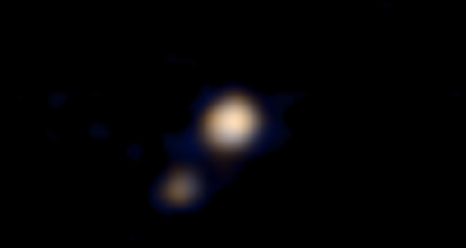NASA's New Horizons Probe Nears Pluto, Releases First-Ever Color Picture

NASA released the first-ever color images of Pluto on Tuesday, captured by its New Horizons probe as the spacecraft continues its marathon journey to the remote dwarf planet. The picture, which was taken by the probe’s Ralph color imager last week, shows the rust-colored Pluto and its biggest moon, Charon, as little more than blurry specks.
But, NASA says it expects to deliver a much closer look soon. "Starting in May, Pluto will get the highest-resolution images ever, and it's going to get better every day from there," Cathy Olkin, a planetary scientist from the Southwest Research Institute, who is working on the mission, told NBC News.
New Horizons, which the space agency calls the “fastest spacecraft ever launched,” will cap its ten-year mission when it performs a flyby of Pluto and its neighboring bodies on July 14, completing its primary mission -- over 3 billion miles from Earth -- of capturing images with a resolution of 400 meters per pixel.
At that distance, it takes radio signals almost five hours to bridge the gap, which means the next phase of the project -- acquiring New Horizons’ trove of images and scientific data -- will take a total of 16 months. NASA will, however, release the pictures as they arrive from the probe.
"This is pure exploration; we're going to turn points of light into a planet and a system of moons before your eyes!" Alan Stern, New Horizons' principal investigator, said in a statement. "New Horizons is flying to Pluto — the biggest, brightest and most complex of the dwarf planets in the Kuiper Belt. This 21st century encounter is going to be an exploration bonanza unparalleled in anticipation since the storied missions of Voyager in the 1980s."
The probe previously delivered high-resolution pictures of Jupiter in 2007, capturing the gas giant and its many moons in unprecedented detail.
New Horizons will offer the biggest leap in planetary photography since the Voyager missions, which first introduced the world to the planets a quarter-century ago when they transmitted close-up pictures of Jupiter, Saturn, Uranus and Neptune, as well as the iconic “Pale Blue Dot” portrait of Earth.
Even after its July flyby, New Horizons will continue working and gathering data for the mission that represents the first close examination of a “binary planet” as well as the mysterious “third zone” of our solar system that lies beyond Neptune's orbit.
"Nothing like this is planned by any space agency ever again," Stern told NBC News. "This is a real moment in time, for you to watch us turn ... a point of light into a planet."
© Copyright IBTimes 2024. All rights reserved.





















